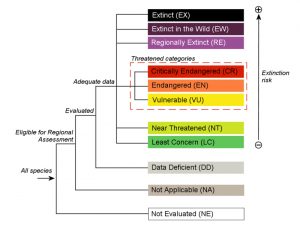The protection of threatened species
In the middle of the 20th century, humanity is becoming more and more aware of its impact on the planet’s biodiversity, since it has directly or indirectly caused a large number of species of flora and fauna to disappear. Various regional, national and international organizations are creating red lists with endangered species, as well as laws and decrees to protect them legally.
Among the lists, the International Union for Conservation of Nature (IUCN) undoubtedly stands out. This is an organization made up of more than 200 states and government agencies, more than 1,100 NGOs and more than 10,000 experts who evaluate the state of natural resources. Thus, a way of evaluating and cataloging species has been standardized, which is then used by almost all countries and scientists in the world to take adequate protection measures for those threatened. It is the IUCN Red List of Threatened Species. https://www.iucnredlist.org/
On the other hand, there is the Convention on International Trade in Endangered Species of Wild Fauna and Flora (CITES), an international agreement concluded between governments. Its purpose is to ensure that international trade in wild animal and plant species (one of the main threats to many species) does not contribute to their extinction. Currently, 183 countries and regional economic integration organizations are part of this convention. https://cites.org/eng

The countries that are part of these institutions are committed to safeguarding their threatened species through laws and other protection activities. In North Africa, with great and valuable biodiversity, the legislation is currently not uniform, with great differences between countries.
Morocco has been protectionist legislation for more than a century, such as the Dahir of October 10, 1917, on the conservation and exploitation of forests, modified in later years (1953, 1959 or 1991). Additionally, to better fit the management and conservation of argan forests, the Dahir of March 4, 1925, on the protection and delimitation of argan forests, was approved. In the following years, this law was modified with texts summarized later in the Dahir of March 28, 1951.
Social participation in forest management was established by the Dahir of September 20, 1976, on Law No. 1- 76-350 on the organization of the participation of the population in the development of the forest economy. Protecting forests has always been a major concern in Morocco, with the desert advancing further and further north. Therefore, in addition to the regulations already established, the Decree of March 21, 2002, was approved, which establishes the limits, conditions and procedures to request and grant compensation for the defense of the forest to be exploited or regenerated. Later, by means of the Dahir of May 12, 2003, they established the basic standards for protecting the environment.
In 2011, was approved Law 29-05, regarding the protection of wild flora and fauna species and the control of their trade and, in 2015, the decree for its application, with a brief additional list of species that were not covered by CITES, such as Moroccan fir (Abies maroccana) or yew (Taxus baccata). Regarding red lists, our collaborator, Mohamed Fennane (with the collaboration of Ibn Tattou, M. & El Oualidi, J.) from the Institut Scientifique de Rabat, has just published (2021) the Red Book of the vascular flora of Morocco.
Algeria also has a relatively advanced body of legislation for the protection of nature. It has an interesting law (of July 19, 2003), relative to the protection of the environment within the framework of sustainable development. In addition, through executive decree 12-03 of January 4, 2012, it establishes its list of protected wild plant species (not cultivated), which repeals the provisions of the previous similar decree of November 23, 1993. The selection criteria are significant of species to be protected: those that are threatened with extinction and those that have an interest in the fields of genetics, medicine, agronomy, economics, culture and science in a general way. In total, a list of 27 pages includes cryptogams, gymnosperms and angiosperms.
In Libya, the protection of the environment has Law number 7/1982. However, as the protection of natural vegetation in general and forests, in particular, was always a major concern, a strong body of legislation was initiated 30 years earlier. Thus, in the middle of the 20th century, Law number 25/1950 on forest protection was approved. Six years later, Law number 12/1956 on forest management. In the 1970s, Law No. 47/1971 on the protection of forests and pastures was published and, in the following decade, Law number 5/1982 on the protection of forests and pastures, modified by Law number 14/1992. In addition to this legislation, Libya has many national parks and nature reserves, in many cases intended to protect its valuable forests.
Several checklists of Libyan flora have been published in recent decades, both regionally and nationally, but the Red List of Threatened Species has yet to be completed.
In Egypt, Environmental Law 4/1994 and its executive regulations approved by decree 388/1995, constitutes the legislative framework for environmental protection in the country and provide for the prohibition of hunting certain species of fauna.
Regarding the assessment of the conservation status of Egyptian flora, in 1991, El Hadidi, Batanouny & Fahmy published the red book of Egyptian trees and shrubs: The Egyptian plant red data book. Volume 1, with 226 pp. A year later, it would be expanded with The Plant Red Data Book of Egypt. In 2000 El Hadidi & Hosni published it as a list in Vol 1 of Flora Aegyptiaca. More recently, Bedair (2020), in his thesis, updates these assessments for the 214 species of trees and shrubs natives of Egypt. In 2021, El Khalafy, Shaltout & Ahmed updated and assessed the conservation status of endemic plants of the Egyptian flora. In 2023, Shaltout & Bedair update the red list of shrubs and small trees of Egypt.
Among the other North African countries that have adopted specific measures by legislating and making lists of threatened and/or protected plant species, the Republic of Mali and its decree 07-155/P-RM of May 10, 2007, should be highlighted. It regulates the authorizations for using a series of wild plants not included in the annexes of CITES.


